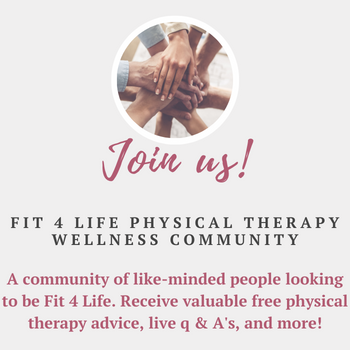I have several patients in my care now with pain on the side of their hips. Three are women in their 40s and one is a young runner. When I see a few patients who have the same problem and I teach them the same thing, it causes me to pause and remember to teach others on the subject. Prevention is the best medicine and I believe lateral hip pain often can be prevented.
Let’s chat about anatomy first. There is a strong and important muscle on the side of the hip called Gluteus Medius. One function of this muscle is to take the leg away from the side of the body while standing. Another important function is to hold the pelvis level when standing on one leg.


As you can imagine, single leg stability of the pelvis, this ability of the Gluteus Medius muscle to hold the pelvis level might be important. When we walk, 50% of the time we stand on one leg while the other leg swings through. So anyone who walks needs to know about this. If you are an athlete and you move at faster speeds, like running or other agility moves, you will want to maximize this muscle’s performance to avoid injuries that may derail you.
I can, and will teach you some of my favorite moves to strengthen your hips but I would be remiss if I didn’t teach you how to protect them first. There are several postures we adopt daily that can weaken this important muscle. Here are my top 3 tips for correcting common postures that weaken the side of your hip:
- Stand with your weight on both feet. When we stand with our weight on one foot (think holding a baby on your hip), we lengthen the muscles on the side of the hip. Lengthened muscles are simply not as strong as muscles who are in their optimal position.
- Avoid crossing your legs. Any time the leg approaches or crosses the midline of your body, you are placing the muscles on the side of the hip in a lengthened position. In fact, if you are experiencing hip pain, I often tell my patients to sit with their legs wide (knees apart…very unlady-like). This shortens the hip muscles and can reduce pain as well. If you must cross your legs, the figure 4 position, commonly used by more men than women, would be an acceptable alternative.
- Sleep on your side with a pillow between your knees. Once again, it’s about that hip to knee angle. Especially for women who tend to have hips wider than knees, when you sleep on your side, you have that lengthening force acting on your hip for hours. Not to mention, with this problem, patients often cannot sleep on the painful side due to compression of the side of the hip. Sleep on your back if possible, or on the opposite side, and place a pillow long wise between your knees and ankles.
Here a few of my favorite exercises to strengthen the side of your hip:
1.Clamshells – in sidelying, knees bent and legs stacked on top of each other. Engage your core. Keep your pelvis rolled forward. Lift the top leg in a clamshell motion, going only as far as you can keeping the pelvis level (don’t let it roll back). You don’t have to lift it high to feel the muscles on the side of the hip working.

2. Side Lying hip abduction – in sidelying, this time with the bottom leg bent and the top leg straight. Engage your core, keep your pelvis rolled forward, lift the top leg up and slight back, on about a 45 degree angle. You should quickly feel this on the side of the hip. You only need to lift 8-10 inches.

3. Side plank – lying on one side, support yourself on your elbow and forearm and stack your feet on top of the other. If you need to modify, you can lower the bottom knee to the ground and perform the side plank from this position. Hold yourself straight like a board (aka plank) for as long as possible. Repeat both sides.

4. Monster walks – place a resistance band or loop around your lower leg or above the knee as shown here. Bend your knees slightly, hips shift back, into what is also called the “ready” or athletic position. Keep this slight bend in the knee and your feet shoulder width apart. Step to the side several times one way, then repeat in the other direction. You should feel this in the muscles on the side of the hip.
5. Single leg deadlift – aka Forward T, this is one of my favorite moves because of how many muscles it works. Standing on one leg, begin without any weight in your hands. Keep your standing leg relatively straight, a slight bend is okay. Engage your core while you kick the other leg back. This leg should remain straight, as well as your back, so the result is a FORWARD T. Use your standing leg to return to the starting position. This works the lateral hip as well as your core, glutes, and hamstrings. When you add weights, it also works the shoulder and back muscles.

Do you have pain in the side of your hips?
What questions do you have for me?
Disclaimer: this blog does not take the place of a full physical therapy evaluation. If you are experiencing pain, it is my recommendation to make an appointment so your physical therapist can accurately assess and diagnose your problem and then grade the exercises specifically to your fitness level.






